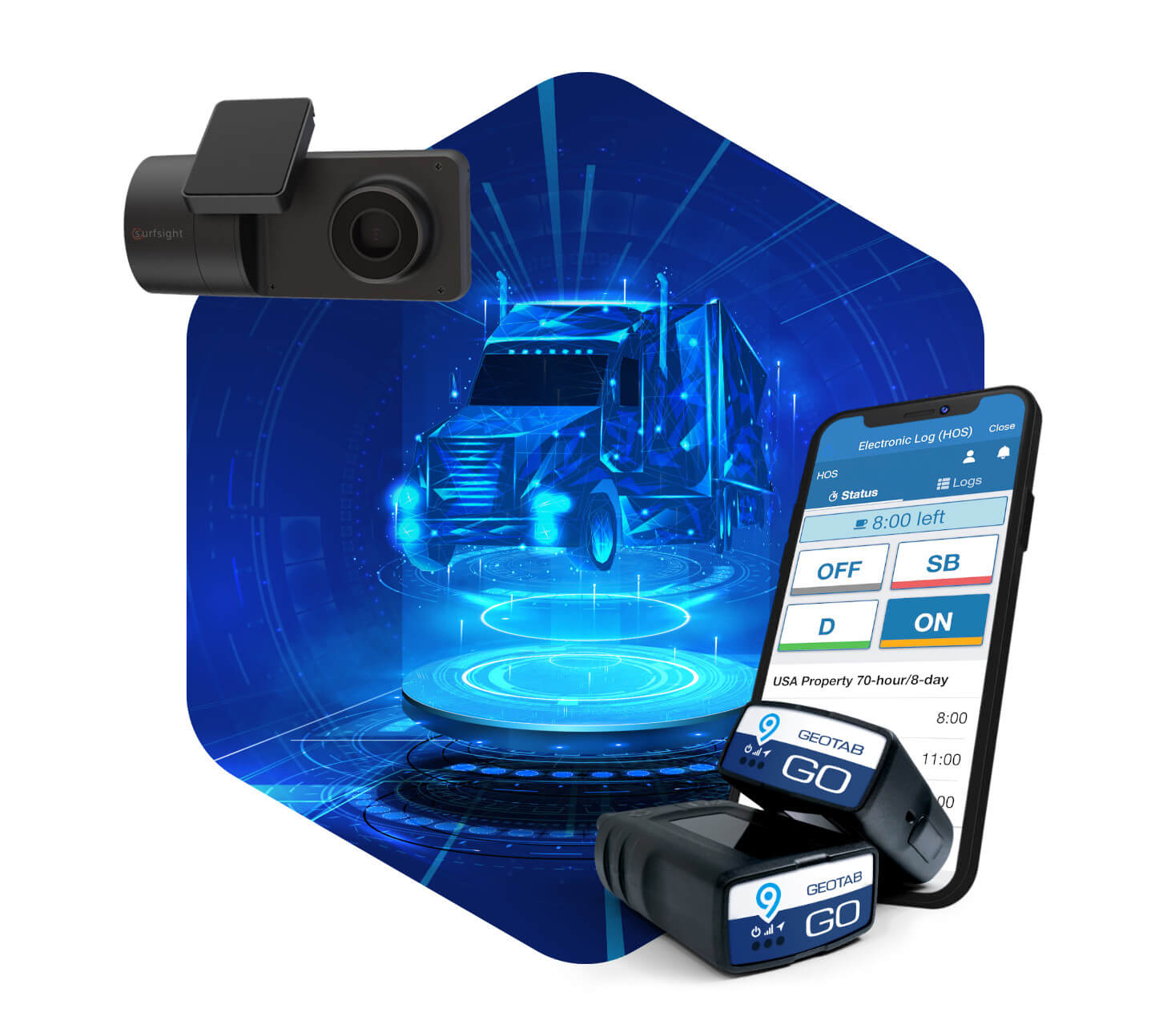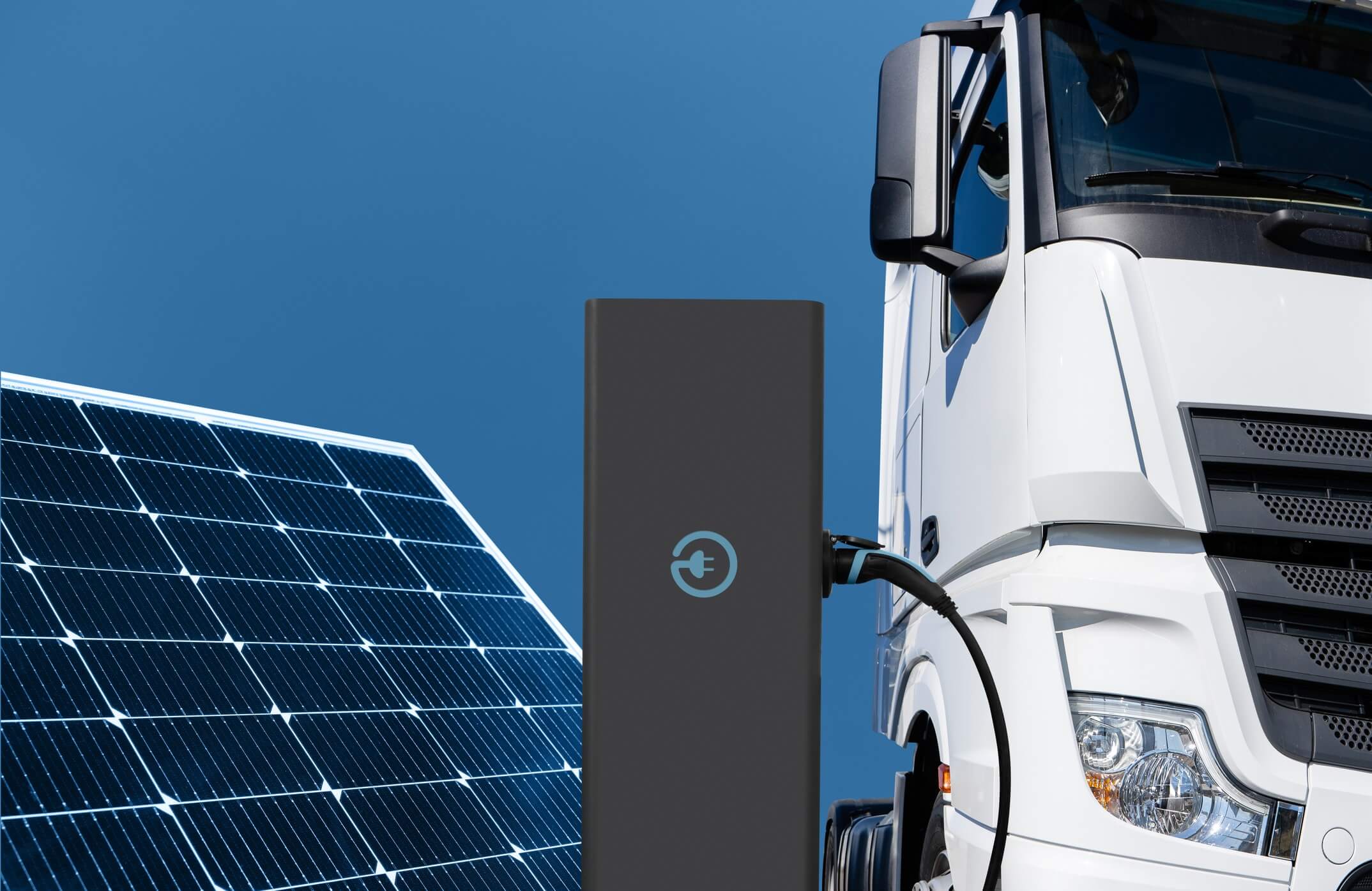The Road Ahead: Key Trends and Innovations in Telematics
Telematics has become a cornerstone of modern fleet management, transforming how carriers operate in a fast-paced industry. While its original applications — such as compliance with Hours of Service and Driver Vehicle Inspection Report (DVIR) regulations — are now standard, telematics has evolved far beyond these initial use cases.
Telematics capabilities are advancing at an unprecedented rate, offering new features that deliver a treasure trove of actionable insights, boost operational efficiency, and enhance safety across the board. From predictive analytics to integration with AI-driven platforms, telematics is redefining the future of fleet management.
This report explores the key innovations and trends poised to shape telematics in 2025 and beyond. We’ll dive into eight developments driving the next wave of efficiency, safety, and sustainability for the transportation industry.


Part 1
Predictive maintenance with connected fleet solutions
Predictive maintenance enables carriers to transition from reactive repairs to proactive planning. By leveraging advanced telematics systems, connected fleets can predict maintenance needs with remarkable accuracy, reducing downtime, optimizing costs, and extending the lifespan of vehicles.
Transforming maintenance schedules
Traditional vehicle maintenance often follows a rigid schedule based on mileage or time, which can either result in premature servicing or unexpected breakdowns. Predictive maintenance, powered by telematics and data analytics, eliminates this guesswork. By continuously monitoring vehicle performance, these systems can identify subtle changes — such as abnormal engine vibrations or temperature fluctuations — that signal potential issues.
For example, sensors integrated into the braking system can detect wear patterns, alerting fleet managers and drivers when pads need replacement before they become a safety hazard. Similarly, telematics can track engine diagnostics and environmental conditions, predicting potential failures well in advance. This proactive approach allows carriers to align maintenance schedules with actual vehicle needs, minimizing disruptions.
Cost savings and operational benefits
The financial impact of predictive maintenance is substantial. Unplanned downtime not only incurs repair costs but also affects schedules and customer satisfaction. By addressing issues before they escalate, predictive systems significantly reduce these risks.
For instance, repairing a minor component early can prevent a domino effect of failures. Moreover, predictive analytics optimize part procurement, allowing fleet managers and others who order parts to obtain necessary components in advance rather than paying a premium for expedited shipping during emergencies.
Nearly real-time data also enhances operational efficiency. Telematics systems provide actionable insights into driver behavior and vehicle usage, helping carriers balance workloads and reduce unnecessary strain on specific vehicles. Over time, these measures contribute to better fuel efficiency and lower overall operational costs.
IoT and nearly real-time data: The backbone of predictive analytics
At the heart of predictive maintenance lies the Internet of Things (IoT) and near-real-time data collection. IoT-enabled sensors embedded in vehicles continuously relay data on engine health, tire pressure, fuel consumption, and more to a centralized telematics platform.
Advanced algorithms analyze this data, identifying patterns that correlate with wear and tear. For example, tire pressure sensors can detect gradual air loss, triggering alerts to prevent blowouts. Similarly, fuel sensors can monitor injector performance, optimizing fuel usage and identifying potential clogs before they affect engine efficiency.
In addition to hardware, software platforms play a critical role. Machine learning models improve their accuracy over time, refining predictions as they ingest more data. This continuous learning loop ensures that predictive maintenance systems stay ahead of evolving challenges.
Part 2
Increasing prevalence of AI in telematics
Artificial intelligence (AI) offers transformative potential for route planning, fuel optimization, and asset management. By leveraging advanced data analytics, AI enables fleets to make informed decisions faster, while reducing operational complexity. As telematics systems collect vast amounts of data, AI provides the tools to translate this data into actionable insights, streamlining fleet operations and boosting efficiency.
Enhancing decision-making through AI
One notable innovation in this field is Assured Telematics’ ASK (ATI Simplified Knowledge) technology, an AI-powered tool integrated into the MyGeotab platform. ASK simplifies fleet management by embedding Power BI dashboards that provide nearly real-time, interactive data visualizations. These dashboards equip users with predictive analytics, enabling fleets to anticipate maintenance needs, optimize routes, and manage costs with precision.
What sets ASK apart is its intuitive interface, which makes analytics accessible to all team members — no prior expertise required. Its use of Natural Language Processing (NLP) and Azure Predictive Analytics empower fleets to forecast trends and respond proactively, enhancing operational agility without overcomplicating processes.
Looking ahead: Autonomous vehicles and AI-assisted navigation
As the industry begins deploying autonomous vehicle trials, telematics will play a pivotal role in enabling AI-assisted navigation. These systems are expected to integrate with vehicle sensors to provide dynamic decision-making capabilities, ensuring optimal routing, fuel efficiency, and safety compliance. AI’s ability to learn from historical and current data positions it as an indispensable tool in managing the complex demands of autonomous and semi-autonomous fleets.
By blending intuitive analytics with advanced automation, AI in telematics is setting a new standard for fleet efficiency, helping carriers stay competitive in an increasingly data-driven industry.
Part 3
AI-powered dash cameras for safety monitoring
AI-powered dash cameras are active participants in improving driver behavior and mitigating risk in real time. By analyzing driving patterns, providing instant feedback, and capturing detailed incident data, these systems offer a proactive approach to safety.
Risk mitigation and coaching
AI-equipped dash cameras do more than detect speeding or harsh braking. They analyze nuanced behaviors such as tailgating, distracted driving, or signs of fatigue. In-cabin audio prompts can alert drivers in real time, helping them adjust behavior before risks escalate. These instant notifications, if enabled, serve as virtual co-pilots, supporting safer driving habits on the go.
Data-driven insights for fleet managers
For fleet managers, AI-powered dash cams provide unparalleled visibility into driver performance. By capturing and analyzing driving data, managers can identify patterns, pinpoint high-risk behaviors, and tailor coaching to individual needs. Over time, this targeted approach strengthens overall fleet safety and fosters a culture of accountability.
Proven results in safety and cost reduction
The adoption of AI dash cameras has shown measurable improvements in safety metrics. For example, insights from Lytx highlight significant reductions in accident rates and associated costs. Fleets using Lytx’s advanced solutions have also reported lower insurance premiums and operational savings.
Technology that learns and adapts
AI systems continually refine their accuracy by learning from new data. They differentiate between minor incidents and critical events, enabling fleet managers to prioritize responses effectively. This adaptability ensures that safety programs stay dynamic and effective, addressing both immediate risks and long-term trends.
By integrating AI-powered dash cameras, fleets not only protect their drivers but also enhance operational efficiency and reduce liability. Advanced solutions like Lytx’s DriveCam® deliver near-real-time alerts and valuable analytics, proving that safety technology is a strategic asset for modern fleet management.

Part 4
The growing role of electric vehicles (EVs) in fleet management
Electric vehicles (EVs) also show transformative potential and compelling benefits like lower operational costs, reduced emissions, and high driver satisfaction. Despite these advantages, the road to widespread EV adoption is not without challenges. For fleet operators and those who use a full suite of telematics hardware and software, understanding the nuances of EV integration is essential.
EV adoption: Opportunities and challenges
Adoption of EVs is accelerating among fleets. While only 14% of fleets currently operate EVs, the future outlook is promising — 87% of fleet operators intend to add EVs to their operations, with most aiming to make significant investments in the next vehicle procurement cycle. Among those already utilizing EVs, 90% plan to acquire additional vehicles.
However, enthusiasm is tempered by challenges. High acquisition costs, limited charging infrastructure, and concerns about battery range and lifespan are common hurdles. While EV maintenance generally focuses on predictable wear-and-tear items like tires and brakes, battery replacement costs remain a critical concern for many fleet operators. Additionally, fleets must address the variability in charging infrastructure, particularly in rural or less-developed areas, to ensure operational continuity.
Scaling infrastructure: Addressing a core need
Charging infrastructure is a cornerstone of successful fleet electrification. Without adequate charging solutions, even the most forward-thinking and ambitious EV strategies can falter. Fleet operators can take several steps to ensure they scale infrastructure needs effectively:
- Evaluate energy needs comprehensively by forecasting total demand, including non-vehicle power requirements, and engaging utilities early to avoid capacity constraints.
- Partner with equipment manufacturers (OEMs) to guarantee charger compatibility with fleet vehicles and to secure post-installation support.
- Adopt phased deployment strategies, starting with pilot programs that test EV applications, allowing fleets to scale intelligently as technology evolves.
- Incorporate cybersecurity measures into charging infrastructure plans to protect against vulnerabilities across devices, networks, and cloud systems.
The role of telematics in EV optimization
Telematics systems have become indispensable for managing EV fleets. By providing live data on battery health, charging behaviors, and vehicle performance, telematics enables fleet managers to:
- Optimize routes to conserve energy and avoid disruptions.
- Implement predictive maintenance strategies to minimize downtime and lower long-term costs.
- Enhance driver behavior, using data-driven feedback to improve efficiency and safety while extending battery life.
This technology also aids in navigating the transition from traditional fleets to electric ones, offering insights into infrastructure requirements, energy management, and operational adjustments.
Government incentives can fuel the transition
Supportive government policies and incentives are pivotal for driving EV adoption in fleets. Financial perks such as tax credits, rebates, and grants for EV charging infrastructure could significantly offset the upfront costs of EV procurement. Additionally, zero-emission vehicle mandates and stricter penalties for internal combustion engine (ICE) vehicles in clean-air zones create economic incentives to electrify.

Part 5
Fleet sustainability beyond electric vehicles
While electric vehicles (EVs) are a pivotal step toward reducing emissions, sustainable fleet management extends far beyond electrification. Fleets that embrace telematics and adopt innovative strategies will not only reduce their environmental impact but also gain a competitive edge in an increasingly eco-conscious market.
Corporate sustainability trends in transportation
The pressure to reduce environmental impact is mounting across industries, with corporate sustainability goals driving significant change in the transportation sector. In 2021, 28% of U.S. greenhouse gas emissions came from transportation, with road vehicles contributing 81% of that ratio.
Organizations are now prioritizing sustainability not only to meet regulatory requirements but also to align with the values of customers, investors, and employees. For fleets, this means adopting practices that cut emissions and enhance operational efficiency.
Telematics is a foundational component of fleet sustainability
Telematics plays a critical role in achieving fleet sustainability by providing insights into vehicle performance, driver behavior, and operational metrics. By analyzing telematics data, fleets can identify inefficiencies and implement measures that reduce fuel consumption and emissions, such as:
- Route optimization Planning the most efficient routes minimizes mileage, reduces fuel consumption, and avoids congested areas.
- Idle reduction technologies Telematics can monitor idling times and send alerts to drivers, significantly cutting fuel waste and emissions.
- Driver behavior monitoring Identifying aggressive driving behaviors like rapid acceleration or harsh braking allows fleets to provide targeted coaching that enhances fuel efficiency.
Strategies for fleet-wide sustainability
Beyond individual vehicles, fleets are adopting holistic sustainability strategies:
- Data-driven decisions Leveraging telematics data allows fleets to track metrics like CO2 emissions and miles per gallon, benchmark performance, and set measurable improvement goals.
- Rightsizing fleets By assessing vehicle utilization and replacing underperforming assets, fleets can reduce fuel consumption and maintenance costs.
- Preventative maintenance Keeping vehicles in peak condition improves fuel efficiency and extends asset life, reducing the environmental impact of replacements.

Part 6
Vehicle-to-everything (V2X) communication
Vehicle-to-Everything (V2X) communication represents a transformative leap in fleet connectivity, enabling vehicles to interact with other vehicles (V2V), infrastructure (V2I), pedestrians (V2P), and networks (V2N). By fostering nearly real-time communication within the broader transportation ecosystem, V2X technology promises safer roads, smoother traffic, and greater operational efficiency.
Revolutionizing fleet connectivity
V2X technology extends beyond traditional telematics, creating a dynamic, interconnected network. Vehicles equipped with V2X systems share data on speed, position, and driving conditions with nearby vehicles and infrastructure. For example, a vehicle can warn others about sudden braking or slippery roads, enhancing situational awareness and reducing collision risks.
For fleets, V2X means more efficient routing, as vehicles receive updates on traffic conditions, road closures, and construction zones in real time. This streamlines operations and minimizes delays, saving fuel and reducing costs.
Enhanced road safety
Safety is at the core of V2X innovation. Through V2V and V2I communication, fleets can leverage features like collision avoidance, emergency vehicle prioritization, and advanced warning systems for red lights or work zones. V2P capabilities further protect pedestrians by detecting their presence — especially those using connected devices — even when visibility is limited.
This proactive approach to safety could significantly reduce accidents, making V2X a vital tool for compliance with evolving safety regulations and for demonstrating a commitment to corporate social responsibility.
The role of telematics in V2X
Modern telematics systems are the backbone of V2X communication, integrating AI, machine learning, and advanced sensors. These systems process the vast amount of data generated by connected vehicles, enabling predictive analytics, automated decision-making, and seamless interaction with cloud-based networks.
With telematics evolving rapidly, fleets can unlock new capabilities such as dynamic route optimization, vehicle health monitoring, and over-the-air updates. The synergy between telematics and V2X creates a future-ready fleet ecosystem.
Future of fleet management with V2X
As V2X adoption grows, fleets will experience unparalleled opportunities to enhance safety, efficiency, and sustainability. While universal implementation requires widespread adoption among road users, the long-term benefits — including reduced fuel consumption, fewer accidents, and streamlined logistics — make V2X a game-changer for the transportation industry.
By embracing V2X-enabled telematics solutions today, fleets can position themselves as leaders in innovation, setting the standard for safety and operational excellence in a connected transportation future.
Part 7
Telematics and insurance cost reduction
In an era of rising insurance premiums and increased claim complexity, telematics has emerged as a critical tool for mitigating costs and enhancing fleet safety. By leveraging live data and analytics, telematics solutions empower carriers to reduce risks, streamline claims processes, and secure more favorable insurance rates.
Driving premiums down with safer operations
Insurance providers often reward fleets that demonstrate strong safety records, and telematics provides the data to prove it. From monitoring driver behavior to implementing advanced driver assistance systems (ADAS), telematics helps fleets identify unsafe practices, coach drivers, and foster a safety-first culture. This proactive approach not only reduces accident frequency but also strengthens the case for lower insurance premiums.
Usage-based insurance (UBI): A tailored approach
Along those lines, Usage-Based Insurance (UBI) leverages telematics to customize premiums based on actual vehicle usage and risk exposure. Instead of one-size-fits-all pricing, insurers can use data on mileage, routes, and driving behaviors to assess individual risk levels. This precision benefits fleets by aligning premiums with actual operations, rewarding safer driving, and addressing concerns about overpaying for coverage.
Simplified and accurate claims management
Telematics also revolutionizes the claims process by delivering precise incident data. In the event of an accident, GPS data, speed metrics, and dashcam footage provide objective evidence that can reduce disputes and expedite settlements. This transparency not only lowers administrative burdens but also minimizes the financial impact of contentious claims.
Part 8
Cybersecurity in telematics systems
As fleets increasingly rely on telematics for real-time data and connectivity, cybersecurity concerns have escalated. Protecting these systems from cyber threats is vital to ensure operational continuity, safeguard sensitive data, and maintain compliance with legal regulations.
The cybersecurity threat landscape for telematics
Connected fleets face diverse threats, including ransomware attacks, unauthorized access to vehicle controls, and data breaches. Hackers can exploit vulnerabilities in telematics systems to disrupt fleet operations or steal critical information such as driver records and routing data. These risks highlight the growing need for robust defenses.
Best practices for securing telematics data
- Implement layered security measures Use firewalls to block unauthorized access and encrypt data during transmission and storage to prevent interception or tampering. Incorporating multi-factor authentication (MFA) ensures only authorized personnel can access sensitive systems by requiring multiple forms of identification.
- Regularly update software Keep telematics systems updated to address vulnerabilities and maintain compatibility with the latest security protocols, ensuring continuous protection against emerging threats.
- Train employees on cybersecurity awareness Equip staff with the knowledge to identify phishing attacks, recognize suspicious activity, and follow best practices, creating a strong human defense against cyber threats.
- Establish robust data backup and recovery plans Regularly back up telematics data to enable quick restoration of operations after a breach or cyberattack, minimizing downtime and data loss while ensuring business continuity.
Navigating regulatory frameworks
Data privacy regulations like GDPR and CCPA mandate stringent protection of telematics data. Fleets must ensure:
- Transparency with drivers about data usage.
- Regular audits and risk assessments to identify vulnerabilities.
- Compliance with privacy laws to avoid penalties and maintain trust.
By prioritizing cybersecurity, fleets can confidently leverage telematics to enhance efficiency and safety while mitigating the risks of a connected ecosystem.
Driving success with telematics
The evolution of telematics is reshaping the transportation industry, empowering fleets with advanced tools to optimize operations, enhance safety, and embrace sustainability. From predictive maintenance to AI-driven analytics, telematics systems have moved beyond traditional tracking to become central to modern fleet management strategies.
Carriers leveraging these innovations can transform challenges into opportunities. Predictive analytics minimize downtime and costs, while AI improves decision-making and enhances safety on the road. As electric vehicles and sustainability initiatives gain traction, telematics ensure fleets remain competitive by providing actionable insights and streamlining the transition to eco-friendly operations.
However, these advancements require vigilance. Cybersecurity threats must be addressed proactively, with robust defenses to protect sensitive data and ensure system integrity. Fleets that follow best practices and comply with regulatory frameworks will not only safeguard their operations but also build trust with stakeholders.
Telematics represents a bridge to the future of fleet management. By embracing its potential today, carriers can position themselves as leaders in a rapidly evolving industry. The journey ahead promises innovation and growth, and those prepared to adapt will reap the rewards of greater efficiency, reduced costs, and a safer, more sustainable transportation landscape.
See how Transflo supercharges your operations
Request a personalized demo of Transflo to unlock extraordinary efficiency across your fleet operations.